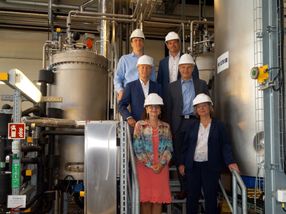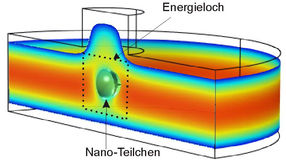Start-up wants to build the world's first stellarator-based fusion power plant in the 2030s
Proxima Fusion raises €130M Series A: “Fusion energy is entering a new era—moving from lab-based science to industrial-scale engineering”
Advertisement
Europe’s fastest-growing fusion startup unlocks funding to advance commercial fusion technology and secure Energy resilience for the continent.
Proxima Fusion, Europe’s fastest-growing fusion energy startup, announced the close of a €130 million ($150 million) Series A funding round—marking it the largest private fusion investment round in Europe.
The Series A round was co-led by Cherry Ventures and Balderton Capital, with significant participation from UVC Partners, the DeepTech & Climate Fonds (DTCF), Plural, Leitmotif, Lightspeed, Bayern Kapital, HTGF, Club degli Investitori, OMNES Capital and Elaia Partners.
This brings Proxima Fusion’s total funding to more than €185 million ($200 million) in public and private capital, accelerating its mission to build the world’s first commercial fusion power plant based on a stellarator design.
Francesco Sciortino, CEO and Co-founder of Proxima Fusion, said: “Fusion has become a real, strategic opportunity to shift global energy dependence from natural resources to technological leadership. Proxima is perfectly positioned to harness that momentum by uniting a spectacular engineering and manufacturing team with world-leading research institutions, accelerating the path toward bringing the first European fusion power plant online in the next decade.”
Shifting global energy dependence
Proxima was founded in early 2023 as a spin-out from the Max Planck Institute for Plasma Physics (IPP), with which it continues to work closely together in a public-private partnership to lead Europe into a new era of clean energy. The EU, as well as national governments including Germany, the UK, France and Italy, are increasingly recognizing fusion as a strategic, generational technology essential for energy sovereignty, industrial competitiveness, and carbon-neutral economic growth.
By building on Europe’s long-standing public fusion investment and industrial supply chains, Proxima Fusion is laying the groundwork for a new high-tech energy industry—one that transforms the continent from a leader in fusion research to a global powerhouse in fusion deployment.
“We back founders solving humanity’s hardest problems — and few are bigger than clean, limitless energy,” said Filip Dames, Cherry Ventures Founding Partner. “Proxima Fusion combines Europe’s scientific edge with commercial ambition, turning world-class research into one of the most promising fusion ventures globally. This is deep tech at its best, and a bold signal that Europe can lead on the world stage.”
Proxima is taking a simulation-driven approach to engineering that leverages advanced computing and high-temperature superconducting (HTS) technology to build on the groundbreaking results of the IPP’s W7-X stellarator experiment.
Just earlier this year, together with the IPP, KIT and other partners, Proxima unveiled Stellaris. As the first commercial stellarator concept to integrate physics, engineering, and maintenance considerations from the outset, Stellaris has been widely recognized as a major breakthrough for the fusion industry, advancing the case for quasi-isodynamic (QI) stellarators as the most promising pathway to a commercial fusion power plant.
Daniel Waterhouse, Partner at Balderton Capital, said: “Stellarators aren’t just the most technologically viable approach to fusion energy—they’re the power plants of the future, capable of leading Europe into a new era of clean energy. Proxima has firmly secured its position as the leading European contender in the global race to commercial fusion. We are thrilled to partner with Proxima’s game-changing team of engineers, alongside Europe’s top manufacturers, to build a company that will be transformational for Europe.”
With this new funding, the company will complete its Stellarator Model Coil (SMC) in 2027, a major hardware demonstration that will de-risk HTS technology for stellarators and stimulate European HTS innovation. Proxima will also finalize a site for Alpha, its demo stellarator, for which it is in talks with several European governments already. Alpha is scheduled to begin operations in 2031, and will serve as the key step to demonstrate Q>1 (net energy gain) and move towards a first-of-a-kind fusion power plant . The company will continue to grow its 80+-strong team across its three offices: at the headquarters in Munich, at the Paul Scherrer Institute near Zurich (Switzerland), and at the Culham fusion campus near Oxford (UK).
“Fusion energy is entering a new era—moving from lab-based science to industrial-scale engineering,” said Dr. Francesco Sciortino. “This investment validates our approach and gives us the resources to deliver hardware that will be essential to make clean fusion power a reality.”
Ian Hogarth, Partner at Plural said: “Proxima Fusion exemplifies a new kind of European ambition – a full force effort to develop the world’s first fusion power plant. Since their first round of funding two years ago, Francesco and the team have hit extremely challenging milestones ahead of schedule and hired a team that spans plasma physics, advanced magnet design and simulation experts. Their peer-reviewed stellarator power plant design concept proves that fusion really can be commercially viable, and creates the opportunity for Europe to be first to the target.”
Other news from the department business & finance
Most read news
More news from our other portals
Something is happening in the chemical industry ...
This is what true pioneering spirit looks like: Plenty of innovative start-ups are bringing fresh ideas, lifeblood and entrepreneurial spirit to change tomorrow's world for the better. Immerse yourself in the world of these young companies and take the opportunity to get in touch with the founders.


































































